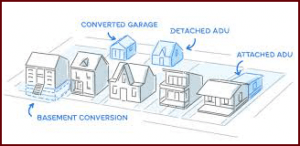Resistance to Accessory Dwelling Units Stifles Rockland’s Growth
By Rick Tannenbaum
 The economics of a community do not function properly when there’s a dearth of affordable housing options. Factories, offices, restaurants, and malls need workers who live in proximity to their workplaces. Main Streets and retail corridors depend on shoppers of all economic levels.
The economics of a community do not function properly when there’s a dearth of affordable housing options. Factories, offices, restaurants, and malls need workers who live in proximity to their workplaces. Main Streets and retail corridors depend on shoppers of all economic levels.
Too often, developers (non-profit and otherwise) seeking to build affordable housing eye parcels beyond the main hubs, with difficult access to Main Streets and transportation. This makes little sense for residents who ultimately occupy these units. Rather than isolate housing units in detached locations from pedestrian hubs, business owners should get behind efforts to pressure towns and villages to relax restrictive building codes and zoning regulations that discourage Accessory Dwelling Units (ADUs).
Elected officials in Rockland County’s towns and villages in recent years have become more aggressive in discouraging or banning ADUs. Their constituents claim to want to preserve the semi-rural character of their neighborhoods. That’s understandable, but it limits options for affordable housing. Businesses need a well-balanced housing market that caters to workers, students, and recent graduates entering the workforce.
Many structures fit the definition of ADUs, also known as granny flats and mother-in-laws: a second small dwelling on the same grounds (or attached to) a single-family house, such as an apartment over a garage; a tiny house (on a foundation) in the backyard; a basement apartment.
Recently, a proposal to build a four-story, 50-unit affordable housing complex on Waldron Avenue in Nyack met with opposition by Clarkstown neighbors. The proposed complex is situated in the Village of Nyack, but physically on its fringe. Angry residents recognized that the proposal ignores the fact that many of these residents don’t have cars, and that the main hub of retail in the Village of Nyack is not at a walkable distance.
Contractors, tradesmen, and realtors too should champion the use of ADUs. Contractors and subs would benefit from needed work, and leasing opportunities would open up for realtors. Many existing but non-identified ADUs would need to be brought up to code to enable realtors to list them for rentals. Increasing population density in the heart of villages would certainly benefit Main Street businesses. Depreciation deductions for rented accessory units may also be available.
ADUs are favored and regulated through most of the country. Rockland County and its Towns have instead set up online complaint forms for neighbors to report on each other and restrictive registry requirements with excessive fines for violations (weekly fines start at $3,500 in Clarkstown, with unpaid fines added to the owner’s property tax) to discourage residents from renting out garage apartments, cottages, and basement units. According to a policy statement prepared for the US Department of Housing and Urban Development, the reduction of restrictive regulations to encourage accessory dwelling units benefit communities and creates an inexpensive way to increase the affordable housing supply and address illegal units already in existence.
Studies of the inclusion of ADUs in Lexington, MA, Santa Cruz, CA, and Portland, OR have shown how ADUs mitigated housing crunches in those areas and enabled seniors, students and moderate income residents to integrate and/or remain in their communities. Zoning and building codes can limit the size of the ADU, the construction, and limit occupancy without the need for punitive annual re-registrations and fees. And, because the units are accessory to the main residential house, they cannot be subdivided and sold off separately.
Apartment vacancy rates in the area hover just above 3%, and demand for market rate units far exceeds the supply of permitted units. Low income or affordable housing is often shunned by NIMBYers wanting to preserve the values of nearby properties. New construction of multi-family buildings is limited, not only by a shortage of building lots, but restrictive zoning and regulations that add expense and months of delay to every new housing venture. According to the National Association of Home Builders and the National MultiFamily Housing Council, regulations and compliance costs account for 32.1% of multifamily development costs.
Sound economic and social policy dictate a re-evaluation of ADUs as a mechanism to open the housing market to workers and provide added economic vitality to Rockland County.
Rick Tannenbaum runs a real estate advisory service for investors, and is a strategic planner and analyst. Reach him at rick.tannenbaum@live.com
Earlier Columns:
Opportunity Knocks on Haverstraw’s Door (November 4, 2018)
Real Estate Investors Rejoice Over New Depreciation Opportunities (October 23, 2018)












